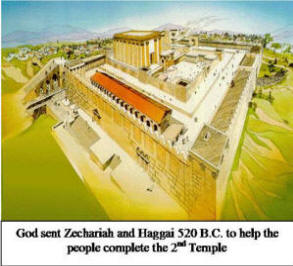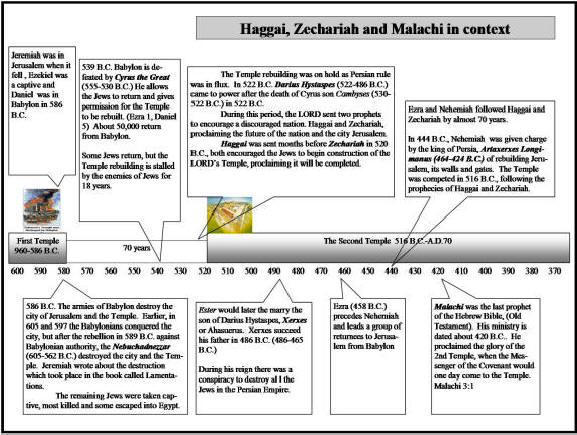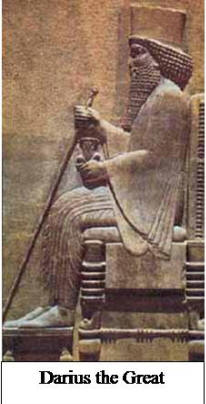|
Introduction
 The
book of Zechariah, contains the words of the prophet
Zechariah, who came to encourage the inhabitants of
Jerusalem.
He along with Haggai urged the inhabitants to complete the
Temple rebuilding project, which had been stalled because of
charges made against the Jews. The
book of Zechariah, contains the words of the prophet
Zechariah, who came to encourage the inhabitants of
Jerusalem.
He along with Haggai urged the inhabitants to complete the
Temple rebuilding project, which had been stalled because of
charges made against the Jews.
Zechariah proclaimed the future glories of Jerusalem, which now
lay desolate, after the Babylonian destruction 66 years earlier.
(Jeremiah 39) In the context of Jerusalem’s desolations, and its
future glory, Zechariah reveals the coming of Jerusalem’s great
king, the Messiah, who would rule the earth.
Second only
to Isaiah, the book of Zechariah has the greatest number of
prophecies regarding the coming of Messiah. Zechariah pictures
both the first and second comings of Messiah (Christ), Zechariah
shows both the “Suffering Messiah” who rides into Jerusalem on a
donkey, and “King Messiah” who rules the earth (Zechariah
9:9-10). The one who is pierced, comes to the aid of Jerusalem
in the last days as the armies of the world surround the city
(Zechariah 12;10), king Messiah returns to rule and reign over
His people during the Millennium
(Zechariah
14:16-21).
Click Here to Expand Chart below

Title
The book is
named after the prophet Zechariah, “Son of Berechiah” the
grandson of Iddo (Zechariah 1:1). Zechariah, like Ezekiel and
Jeremiah was probably a priest. Iddo is mentioned as one of the
priests who returned to Jerusalem in 538 B.C. (Nehemiah 12:4,16)
Zechariah is
called “Son of Iddo”, in Ezra 5:1, and Nehemiah 12:16), but
since there is no term grandson in Hebrew “ben” would mean
descendent of Iddo, son of son.
Historical Background
 The Jews of Jerusalem had been taken captive into Babylon on
three occasions, the first occurred in 605 B.C., when hostages
such as Daniel were taken to secure the peace of the city. The
second occurred in 597 B.C., after the city rebelled against
Babylonian authority, more hostages including Ezekiel (Ezk. 1:1)
were taken. In 586 B.C., the third time, the Babylonians
destroyed the city and the
Temple.
They killed most of the people, took captives including
Jeremiah, who was later forced to go to Egypt with the rebels.
Until the year 539 B.C., the descendents of Judah remained under
Babylonian captivity.
The Jews of Jerusalem had been taken captive into Babylon on
three occasions, the first occurred in 605 B.C., when hostages
such as Daniel were taken to secure the peace of the city. The
second occurred in 597 B.C., after the city rebelled against
Babylonian authority, more hostages including Ezekiel (Ezk. 1:1)
were taken. In 586 B.C., the third time, the Babylonians
destroyed the city and the
Temple.
They killed most of the people, took captives including
Jeremiah, who was later forced to go to Egypt with the rebels.
Until the year 539 B.C., the descendents of Judah remained under
Babylonian captivity.
In 539 B.C. the Persian king, Cyrus the Great defeats Babylon
and allows the Jews to return and rebuild their
Temple.
According to Ezra (Ezra 2:64-67), about 50,000 returned to
Jerusalem.
Opposition soon grew to the Temple rebuilding project, letters
were sent to the king, by enemies of the Jews, accusing them of
rebellion and the Temple building was halted.
In 530 B.C., Cyrus died and was succeeded by his son Cambyses,
who killed his brother in secret, he was an unpopular king,
which led to a Persian revolt. While in
Egypt,
there was a rebellion which occurred led by a Magian, named
Gautna who claimed to be the brother of Cambyses. During this
rebellion in Persia, Cambyses was fatally wounded in Egypt, he
confessed to killing his brother earlier. With this information
Darius, returned to Persia and put down the rebellion and became
king himself in 522 B.C. The empire revolted against his
authority, and he was forced to subdue the rebellious satraps
(governors).
|
Name |
Year |
|
|
Cyrus the Great |
555-530 B.C. |
Cyrus defeats Babylon, allows the Jews to return and
rebuild their
Temple.
He is killed in 530 B.C., succeeded by his son Cambyses. |
|
Cambyses |
530-522 B.C. |
Cambyses goes to war against Egypt and dies, on his
death bed he confesses to killing his brother. Darius, a
commander, and an Achaemenian
returns to
Persia
to stop the rebellion. |
|
Gautna |
522
B.C.
March 11-Sept 29th |
Claimed to be the brother of Cambyses, who died in
Egypt. He was defeated by Darius the Great, who assumed
power. |
|
Darius the Great |
522-485 B.C. |
Darius assumes power after killing Gautana, who claimed
to be Cambyses brother. Its during his reign, Haggai
and Zechariah appear in Jerusalem. |
|
Xerxes |
486-465 B.C. |
Son
of Darius the Great, he is known for being the husband
of Queen Ester. Also the Persian king defeated at
Marathon by the Greeks. |
|
Artaxerxes Longimanus |
465-424 B.C. |
Son
of Xerxes, allowed Nehemiah to rebuild the walls of
Jerusalem. |
In 520 B.C., he allowed the
Temple
construction completion, after a search was made for the Cyrus
decree allowing the Temple to be rebuilt (Ezra 1). When it was
found, Darius allowed the project to move forward.(Ezra 6) He
threatened death to anyone who would prevent its completion.
Haggai and Zechariah urged the people to move forward with the
project, not to fear the people of the land. (Ezra 5:1-3)
Contents
|
Zechariah |
Chapter 1-8 |
|
Zech. 1:1-6 |
General Introduction |
|
Zech.
1:7-6:8 |
Eight Visions of the Night
a.
Vision of the four horses and man among the Myrtle tree
(Zech 1:7-17)
b.
Vision of the four horns and craftsman (Zech
1:18-21)
c.
Vision of man with the measuring line
d.
Visions of the High Priest (Zech 3;1-5)
e.
Vision of the Lamp-stand and two olive trees (Zech.
4:1-14)
f.
Vision of the flying scroll (Zech. 5:1-4)
g.
Vision of women in the basket (Zech. 5:5-11)
h.
Vision of the four chariots (Zech. 6:1-8)
|
|
Zechariah
6:9-8:23 |
Various prophecies
a.
Coronation of Joshua as High Priest (Zech. 6:9-15)
b.
True righteousness versus fasting (Zech 7:1-7)
c.
The glorious future (Zech 8:1-23)
|
|
|
Chapters 9-11 |
|
Zechariah 9:1-
11:17 |
a.
God judgment on the nations (Zech. 9:1-8)
b.
The Messianic Kingdom (Zech. 9:9-17)
c.
God alone the giver of rain (Zech. 10:1-2)
d.
Triumphant deliverance and return of exile (Zech.
10:3-11:3)
e.
Good and Bad shepherds (Zech. 11:4-17) |
|
|
Chapters 12-14 |
|
Zechariah 12-14 |
1.
Future Deliverance and Blessing (Zech. 12:1-14)
2.
Rooting out of Idolatry and False Prophecy (Zech.
13;1-6)
3.
National Purification (Zech. 13:7-9)
4.
The Last Battle (Zech. 14:1-21) |
The Message of Zechariah
Zech
Zechariah is book of hope, presenting to the Jews of Jerusalem
the ultimate triumph of the God of Israel and the establishment
of His kingdom over the world. In the book of Zechariah, both
the First and Second comings of Jesus the Messiah
are described.
The Messiah
is presented as the “BRANCH” (3:8) and God’s shepherd (13:7).
Zechariah also pictures the dual office of Messiah as both
priest and king (6:13)
Messiah the King is pictured entering Jerusalem and a donkey
and yet ruling over the nations (9:9) (See Mat. 21:4-5, John
12:14-16) Messiah is also seen sold for 30-pieces of silver
(11;12,13; see Matthew 27:9-10). He is pierced (12:10, See John
19;37). His death provides a cleansing of sin (13:1)
Regarding the Second Coming, we see the return of the “Pierced”
one at Armageddon when all the nations gather against
Jerusalem. We see the how the armies melt away at the presence
of the Lord in the final conflict (14:12).
|
